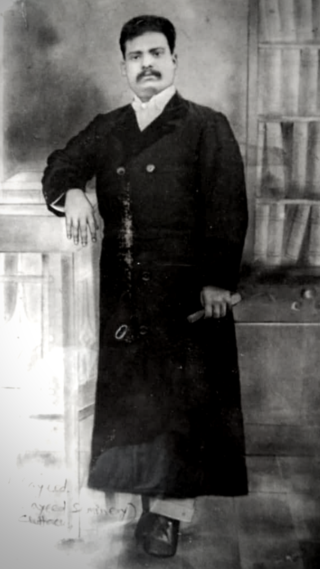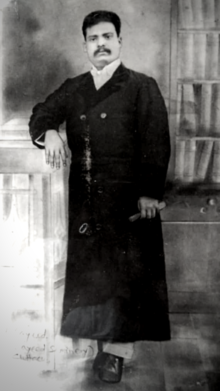
Cuttack in Odia, is the former capital and the second largest city in the Indian state of Odisha. It is the headquarters of the Cuttack district. The name of the city is an anglicised form of the Odia and Sanskrit name Kataka which literally means The Fort, a reference to the ancient Barabati Fort around which the city initially developed. Cuttack is known as the Millennium City as well as the Silver City due to its history of 1000 years and famous silver filigree works. The Orissa High Court is located there. It is the commercial capital of Odisha which hosts many trading and business houses in and around the city. Cuttack is famous for its Durga puja which is one of the most important festivals of Odisha. Cuttack is also the birthplace of Netaji Subhas Chandra Bose. The city is categorised as a Tier-II city as per the ranking system used by Government of India.
The Odia (ଓଡ଼ିଆ), formerly spelled Oriya, is an Indo-Aryan ethnic group native to the Indian state of Odisha who speak the Odia language. They constitute a majority in the eastern coastal state, with significant minority populations in neighboring Andhra Pradesh, Chhattisgarh, Jharkhand and West Bengal.

Srirama Chandra Bhanja Medical College and Hospital is a public medical college in Cuttack in the Indian state of Odisha, named after Srirama Chandra Bhanja.
Previously a neglected aspect of the Indian Central government, Education in Odisha is witnessing a rapid transformation. Its capital city, Bhubaneswar, is emerging as a knowledge hub in India with several new public and private universities, including the establishment of an Indian Institute of Technology after five decades of demand.
Odia Muslims are a community of people hailing from the Indian state of Odisha who follow Islam and primarily speak Odia language. They mostly descend from indigenous converts to Islam along with a small proportion that migrated from northern India. They are marked by their distinctive religious practices, food habits and language.

Gopabandhu Das (1877–1928), popularly known as Utkalamani, was a social worker, reformer, political activist, journalist, poet and essayist.

Odisha Day, also Utkala Dibasa, is celebrated on 1 April in the Indian state of Odisha in memory of the formation of the state as a separate state out of Bihar and Orissa Province with addition of Koraput District and Ganjam District from the Madras Presidency on 1 April 1936. After losing its political identity completely in 1568 following the defeat and demise of the last king Mukunda Dev, efforts resulted in the formation of a politically separate state under British rule on a linguistic basis on 1 April 1936.

Madhusudan Das was an Indian lawyer and social reformer, who founded Utkal Sammilani in 1903 to campaign for the unification of Odisha along with its social and industrial development. He was one of the main persons, helping in the creation of Orissa Province, which was established on 1 April 1936. He was also the first graduate and advocate of Orissa. He is also known as Kulabruddha, Madhu Babu, and Utkal Gouraba. In Odisha, his birthday is celebrated as the Lawyers' Day on 28 April.

Krushna Chandra Gajapati KCIE, also known as Captain Maharaja Sri Sri Sri Krushna Chandra Gajapati Narayana Deba KCIE, was a key personality and regarded as the architect, founding father of an Independent Odia Language speaking state Odisha. He was a scion of Paralakhemundi Estate and the owner of Delanga estate of Puri district of Odisha. His family belonged to the great Eastern Ganga Dynasty. He was the first Prime Minister of Orissa. The present-day Gajapati District of Odisha was named after him.

Ravenshaw Collegiate School is the oldest High School of Odisha which was established in 1851 by Thomas Edward Ravenshaw in the District of Cuttack in Odisha, India. It was one of three institutions founded by Ravenshaw, the other two being the Ravenshaw Girls' School and the Ravenshaw College, the latter now having become Ravenshaw University.

Pandit Nilakantha Das (1884-1967) was one of the most illustrious sons of Odisha, who appeared both in its political and literary arena at the most crucial period of its history, when Odisha had no political identity in the map of India, and Odia as a language was about to be extinct. He worked relentlessly for Odisha's recognition both politically and linguistically, and helped bring to fruition the dreams of Utkala Gaurab Madhusudan Das, Utkalamani Gopabandhu Das and all other Odia loving people.

Binod Kanungo (1912–1990) was an Odia author, freedom fighter, Gandhian, educator, social reformer and compiler of the Gyana Mandala, which is the greatest encyclopaedia in the Odia language. He also won the Odisha Sahitya Akademi Award for his travelogue Runa Parishodha (1983). He was also a veteran freedom fighter and notable educationist. He was awarded with India's fourth highest civilian honour "Padmashree". He died on 22 June 1990.
Mohammad Mohsin called popularly as Mohsin was an Odia actor, director and producer. In his movie career spanning more than 30 years across Bollywood, Odisha and West Bengal, he has acted and directed in many commercially successful movies. Mohsin made his first Bollywood debut in the movie Naiyya, in which he played the character of Karim. Naiyya was produced and distributed by Rajshri Productions, which was a remake of Odia movie Shesha Shrabana, in which Mohsin played the character of a boat maker.

Kuntala Kumari Sabat (1901–1938) was an Odia poet during colonial India. She was one of the women poets who came into prominence from Odisha during India's freedom struggle. She was multifaceted personality. She was a physician, writer, poet, editor, leader of nationalist movement and social worker. She was honored with Utkala Bharati in 1925.

Hussain Rabi Gandhi was an Indian Odia writer of the late-twentieth century, a politician and a cultural activist hailing from the Indian state of Odisha. Being a founder member of Biju Janata Dal, he served as the general secretary of the party from upon its formation in 1998 till 2005. In 1994 the title of Biplabi Loka Kabi was conferred upon him by the Mayor of Cuttack. He was also awarded with the title of Utkala Jyoti in 1996 by the then Deputy chief minister of Odisha, Basant Kumar Biswal on the behalf of Freedom Fighter's Organisation. Gandhi primarily wrote in Odia language and was bestowed with the Secular India Harmony Award in 1993 by the former President of India, Giani Zail Singh and with the Gangadhar Meher Kabita award in 2015 for his notable contributions to the field of Odia poetry. Hussain served as the President of Odisha Sahitya Akademi (2008–2010). He was famously known as the Gandhi of Korei and was regarded as a bridge between Western Odisha and Costal Odisha. He also served as Lead Member of Smt. Nandini Satpathy Memorial Trust (SNSMT).

Sayeed Mohammed was an Indian Odia educationist, freedom fighter and philanthropist. In 1913, he founded the Moslem Seminary at Cuttack, which is regarded as the second nationalist school of Odisha. Sayeed is known for his activism against the British in the early 1900s. He was one of the prominent members of the Utkal Sammilani. In 1922, Sayeed along with Ekram Rasul co-founded the All Odisha Khilafat Committee, in the wake of the Non cooperation movement in India.

Mohammed Afzal-ul Amin, popularly known as M.A. Amin, was an Indian statesman, politician and social worker from Cuttack, Odisha. He served as the general secretary of Utkal Pradesh Congress Committee during Biren Mitra's chief ministership. Afzal-ul was the Vice Chairman and later the Chairman of Cuttack Municipality and also the President of Odisha Mohammadan Association. He played a major role in preserving Urdu language in Cuttack by establishing several lower primary and upper primary Urdu schools in the city. He is also credited for organising various nationalist meetings and for mobilizing the common masses in Cuttack during the Quit India movement of 1942.
Atharuddin Mohammed also known as Athar Mohammed was an Odia military officer, feudatory chief (Samanta) of Madhi and the Dewan of the princely state of Dhenkanal during Raja Dinabandhu Mahendra Bahadur and Raja Shura Pratap Mahendra Bahadur's rule. He was one among the first princely officials to join the Odia unification movement and the Utkal Sabha.
Begum Badar un Nissa Akhtar was an Indian social reformer and educator from Cuttack, Odisha. She is known for challenging the stringent and orthodox societal norms and for encouraging and enabling Muslim girls to receive formal and skill based education from behind the purdah back in the early 20th century. Begum herself was formally educated and hence she took up a job as a teacher in Cuttack to educate young girls. She worked to promote female education and to abolish gender discrimination and gender injustice in the field of education. She is regarded as one among the first female teachers and educationists of modern British Odisha. The Badar un nissa Assembly hall at Sayeed Seminary is named after her.
Godabarish Mohapatra was a story writer and poet in Odia literature. He was also a journalist of Odisha, best known as the editor of "Niankhunta", a monthly criticism magazine, and "Tuan Tuin", a monthly children's magazine.















